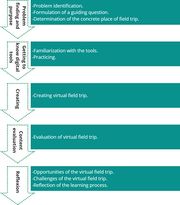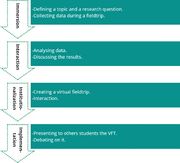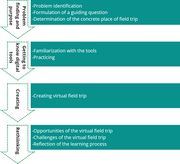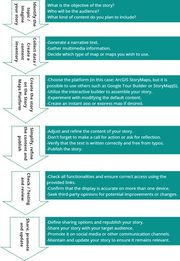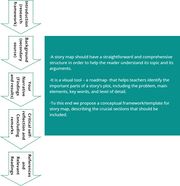Category:4 Different examples of methodological frameworks and VFTs
From V-Global Wiki
In this section, this guide proposes:
- Different methodological workflows and approaches that the project partners have developed and followed during their VFTs creation.
- Different examples of VFTs and experimentations created during the project.
Workflow proposed by the University of Hamburg (UHH)
Problem finding and purpose definition Problem identification
- Formulation of a guiding question
- Determination of the concrete place of field trip
- Getting to know digital tools
Familiarization with the tools
- Practicing
- Creating
Creating virtual field trip
- Content evaluation
Evaluation of virtual field trip
- Reflection
Opportunities of the virtual field trip
- Challenges of the virtual field trip
- Reflection of the learning process
The virtual field trip of Universität Hamburg created for Athens, is participative and includes tools like LimeSurvey or filling the blank.
Workflow proposed by Paris Cité University (UPC)
Immersion
- Defining a topic and a research question
- Collecting data during a field trip
Interaction
- Analyzing data
- Discussing the results
Institutionalization
- Creating a virtual field trip
- Interaction
Implementation
- Presenting to other students the VFT
- Debating on it.
The Université Paris Cité’s Athens Virtual Field Trip is based on a sensory approach to the field. It is enhanced by artistic representations of the space.
Workflow proposed by Eurogeo
Problem finding and purpose definition
- Problem identification
- Formulation of a guiding question
- Determination of the concrete place of the field trip
Getting to know digital tools
- Familiarization with the tools
- Practicing
Creation
- Creating the virtual field trip
Rethinking
- Opportunities for the virtual field trip
- Challenges of the virtual field trip
- Reflection of the learning process
The Athens Virtual Field Trip developed by Eurogéo is based on a more conceptual (with a heuristic map) and visual approach with visual panoramas of the area.
Workflow proposed by National University of Distance Education (Universidad Nacional de Educación a Distancia - UNED)
Identify the topic / Imagine your story
- What is the objective of the story?
- Who will be the audience?
- What kind of content do you plan to include?
Collect data and resources / Create a content inventory
- Generate a narrative text.
- Gather multimedia information.
- Decide which type of map or maps you wish to use.
Create the story on the Story Maps Platform
- Choose the platform (in this case: ArcGIS StoryMaps, but it is possible to use others such as Google Tour Builder or StoryMapJS).
- Utilize the interactive builder to assemble your story.
- Experiment with modifying the default content.
- Create an instant app or express map if desired.
Simplify, refine the content and publish
- Adjust and refine the content of your story.
- Don't forget to make a call for action or ask for reflection.
- Verify that the text is written correctly and free from typos.
- Publish the story.
Check / Testing and review
- Check all functionalities and ensure correct access using the provided links.
- Confirm that the display is accurate on more than one device.
- Seek third-party opinions for potential improvements or changes.
Share, promote and update
- Define sharing options and republish your story.
- Share your story with your target audience.
- Promote it on social media or other communication channels.
- Maintain and update your story to ensure it remains relevant.
Workflow proposed by National Technical University of Athens (NTUA) & commonspace
- Introduction, describing the research framework:
Describe the research motives, problem/issue that you addressing, as well as the research objectives and the research questions
- Background, formulated by secondary sources:
Explore secondary sources (coming from literature or other sources) to describe the theoretical, conceptual and geographical background of your work
- Your Narrative (Findings and Results), as framed by your primary data:
In this step, form your storymap's narrative, using the primary data that you have collected
- Critical self-reflection and Concluding remarks:
This step refers to the conclusion of the storymap
- References, Bibliography, Relevant Readings, and Additional Material:
All references and sources used for the storymap should be included, as well as additional relevant readings and other useful material.
Commonspace has developed an Athens virtual field trip on the scenes of everyday life with both an interpretation of spatial practices and an illustrated road trip.
NTUA’s virtual field trip focuses on the diverse aspects of Athens's "sustainable" urban form put in perspective with a spatial reading of the city. It was also presented as a poster at the ISUF 2023 conference.
This category currently contains no pages or media.
